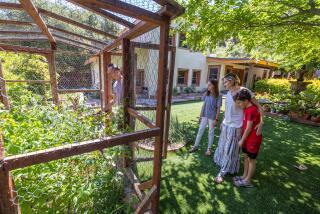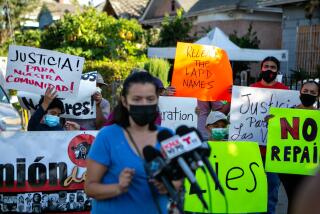Sitting on a Powder Keg : City Where Shell Killed 2 Boys Waits for Promised Ordnance Cleanup
SAN DIEGO — Near the end of a street of neat, brown-shingle homes, where girls cartwheel across manicured lawns and boys ride brightly colored bikes, an ominous sign warns that the hillside below the cul-de-sac has not been swept for unexploded ordnance.
Suzanne Gillick-Pew, whose 8-year-old son was killed less than 10 yards from where the sign now stands when an abandoned, World War II-era mortar round exploded, said the warning is long overdue.
On Dec. 10, 1983, her son Matthew Smith, 8-year-old Corey Peake and Corey’s 12-year-old brother, Carl, discovered an unexploded shell while playing “fort” with friends in the northern San Diego community of Tierrasanta. Matt picked up the round and threw it into the brush. Corey retrieved it. Then one of the boys banged it against a rock and it detonated, instantly killing Matt and Corey and injuring Carl.
$6.5-Million in Settlements
The families of the two dead boys received a total of $6.3 million last April in out-of-court settlements with San Diego County, city and the developers and builder of the 2,600-acre community.
Last November, the city finally posted 81 signs in 64 locations warning residents that they live atop what during World War II was a Marine Corps artillery range. Cruz Gonzalez, director of the city’s risk management department, said the city paid about $2 million to the two families without admitting any liability. The city was not required to post the signs, he said.
The city decided in July to erect the signs at a cost of about $7,000, less than a week after a crew from ABC-TV’s “20/20” went to Tierrasanta to film a story on the ordnance problem. For months the city had refused requests by the boys’ families to post warnings, prompting Superior Court Judge Dennis Adams, who presided over the case, to label the city’s position as “totally outrageous.”
Gonzalez denied that the posting of the signs had anything to do with the airing of the “20/20” segment, saying that the city had merely “bowed” to wishes of Tierrasanta residents.
“We just didn’t think there was a need, but we got a lot of requests from the community,” he said. “We decided to put up the signs as an added precaution.”
John Madaffer, chairman of the Tierrasanta Community Council, said, “It was interesting that it was so coincidentally close” but also said he does not believe that the city acted as a result of the television program.
The new signs explain that Tierrasanta was once part of Camp Elliott, a 13,000-acre Marine Corps base for artillery and tank training. The bottom part of the sign reads: “This area has not been swept for unexploded shells. It is currently slated to be done.”
The U. S. Army Corps of Engineers, which will conduct subsurface sweeps with electromagnetic equipment to find unexposed shells, said it is uncertain when the sweeps will begin.
Part of the reason for the delay is that federal officials are worried about damaging the hillsides and canyons and so must proceed with caution. Corps spokesman Ken Crawford said that “it may be spring of 1990” before sweeps occur.
Still Seeking Contractor
Another Corps official, Judy Wilson, said the organization is still in the process of selecting a contractor to design a cleanup plan. “It looks like we will be able to make an award for design in the first part of February,” she said.
After that, a contractor still needs to be selected to do the actual cleanup, said Maj. Gene Miller, project manager of a feasibility study of the ordnance danger done last April.
What is clear, however, is that no one knows how long the cleanup will take. It could take years or it could become a process almost without end, with continuous sweeps taking place indefinitely. Wilson said it will be a “torturous” process.
The Corps estimates that there are 263 hazardous items, or “devices that are considered dangerous,” in the Tierrasanta area. According to the April feasibility study, there are more than 66,000 pieces of ordnance-related contamination that are not considered hazardous, including shell fragments, grenade spoons and shotgun shells.
A long-term concern of many residents is that rainfall and erosion will bring more shells to the surface, said Deanna Spehn, editor of the Tierra Times and chairwoman of the Community Council’s ordnance committee. “We want sweeps every year, forever,” she said.
Gillick-Pew agreed, saying she is glad the signs are finally up but that unless more is done to educate other Tierrasanta residents, the neighborhood’s children remain at risk. She said that she has seen children running around on the hillside where her son was killed and that she knows the canyons are irresistible playgrounds.
“If they don’t do more than this, it’s going to happen again. And I’d like to think my son didn’t die in vain,” she said.
Robin Smith, Matt’s father, said he feels the Tierrasanta canyons will continue to pose a threat unless periodic, electronic searches for ordnance are made.
Joanne Peake, Corey’s mother, is also pleased that signs have been posted at trail heads and entrances to most of the open spaces in the canyon, but said she will be much happier when the sweeps start.
“If they had done this years ago, none of this would have ever happened,” Peake said. “What upsets me is when people keep us in the dark. . . . I think that when there’s a little bit of risk, we should be told--something.”
Madaffer of the Community Council said the signs are “only one small part of an overall program of education, awareness and safety,” and he is trying to find a way to require Tierrasanta homeowners to notify renters of the ordnance danger.
People who buy homes in Tierrasanta are told of the danger because state law requires that developers and real estate brokers provide full disclosure, according to Ron Rinehart, assistant manager at Coldwell Banker in Tierrasanta.
Warning From Realtors
Coldwell Banker clients interested in Tierrasanta are told that “some live, unexploded military ordnance has been found and is known to exist in the open space and canyon areas of Tierrasanta . . . (and) in 1986 the government earmarked money for a comprehensive program to clean up this ordnance, and officials are studying how best to accomplish the cleanup,” Rinehart said.
Madaffer and others expressed frustration at bureaucratic delays in cleaning up the site and stressed that residents continue to be made aware of the ordnance danger.
“Five years is too long,” said Karl Higgins, aide to U.S. Rep. Bill Lowery (R-San Diego). Higgins noted that the Corps of Engineers is working on a second feasibility study to assess contamination in east Tierrasanta for another sweep. Gillick-Pew would like to see an education program for the parents in Tierrasanta and a better program in the schools.
Every year, members of the San Diego Fire Department’s explosive device team visit the 12 schools in the Tierrasanta area and lecture students about the dangers of unexploded shells and other ordnance. Department spokeswoman Lonnie Kitch said the 1988-89 lecture series is expected to reach 8,300 students.
The program, which teaches children not to touch any suspicious objects, to mark where they find the objects and to call an adult, began in 1984 in response to the accident the year before, Kitch said.
Gonzalez, the city official, believes that what is being done now--education in the schools, library displays, announcements in the local paper and notification to new homeowners--is sufficient.
But Gillick-Pew said her daughter Kristen, 16, came home from school in tears after hearing firefighters who had come to talk to students say that the boys who played in the Tierrasanta canyons were “bad boys.” Gillick-Pew said she was not sure the firefighters knew how to teach children.
Russ Heyneman, explosive-device technician with the Fire Department, said members of the Explosive Device Team tailored their presentations to each age group and never “condescended”to the students. He said the department is considering expanding the lectures to two a year, before Christmas and summer vacations.
Firefighters have responded to three calls to remove unexploded ordnance since November, when the signs were put in place, he said.
Matt’s father still lives on the cul-de-sac near where his son was killed. Gillick-Pew and Peake have also remained in Tierrasanta.
Smith said he stayed because he feels enough has been done now to warn residents and their children of the danger. He said living there now is more of a “calculated, reasonable risk,” like driving a car.
Gillick-Pew has friends here, and her church is here.
The Peakes suffered another tragedy when Corey’s father died a month after the accident. The family’s lawyers said that he had been suffering from cancer and that the strain of his son’s death was too much.
“They’ve lost a brother, they’ve lost a father, they didn’t want to be moved,” Joanne Peake said of her family. “It was a real security for me to be able to have a home.”
More to Read
Sign up for Essential California
The most important California stories and recommendations in your inbox every morning.
You may occasionally receive promotional content from the Los Angeles Times.










